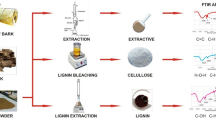Abstract
The chemical constituents of the stems and twigs of Lindera umbellata were investigated, and a new lignan derivative and four known compounds were isolated. The structure of the new compound was established as (2S,3S)-2,3-bis[(4-hydroxy-3,5-dimethoxyphenyl)methyl]-1,4-butanediol 1,4-diferulate on the basis of spectroscopic analysis and the result of alkaline methanolysis. The isolated compounds were evaluated for their scavenging effects on 1,1-diphenyl-2-picrylhydrazyl and O2 − radicals.


Similar content being viewed by others
References
Jiang Su New Medical College (1978) Dictionary of traditional Chinese crude drugs. Shanghai Scientific Technologic, Shanghai, pp 1263, 1364
Shimomura H, Sashida Y, Mimaki Y, Oohara M, Fukai Y (1988) A chalcone derivative from the bark of Lindera umbellata. Phytochemistry 27:3937–3939
Mimaki Y, Kameyama A, Sashida Y, Miyata Y, Fujii A (1995) A novel hexahydrodibenzofuran derivative with potent inhibitory activity of melanin biosynthesis of cultured B-16 melanoma cells from Lindera umbellata bark. Chem Pharm Bull 43:893–895
Yoshinari K, Sashida Y, Shimomura H (1989) Two new lignan xylosides from the barks of Prunus ssiori and Prunus padus. Chem Pharm Bull 37:3301–3303
Sadhu SK, Khatun A, Phattanawasin P, Ohtsuki T, Ishibashi M (2007) Lignan glycosides and flavonoids from Saraca asoca with antioxidant activity. J Nat Med 61:480–482
Chen J-J, Wang T-Y, Hwang T-L (2008) Neolignans, a coumarinolignan, lignan derivatives, and a chromene: anti-inflammatory constituents from Zanthoxylum avicennae. J Nat Prod 71:212–217
Otsuka H, Yao M, Kamada K, Takeda Y (1995) Alangionosides G-M: glycosides of megastigmane derivatives from the leaves of Alangium premnifolium. Chem Pharm Bull 43:754–759
Shibuya H, Takeda Y, Zhang R-S, Tanitame A, Tsai Y-L, Kitagawa I (1992) Indonesian medicinal plants. IV. On the constituents of the bark of Fagara theza (Rutaceae). (2). Lignan glycosides and two apioglucosides. Chem Pharm Bull 40:2639–2646
Kuroda M, Uchida S, Watanabe K, Mimaki Y (2009) Chromones from the tubers of Eranthis cilicica and their antioxidant activity. Phytochemistry 70:288–293
Author information
Authors and Affiliations
Corresponding author
Rights and permissions
About this article
Cite this article
Kuroda, M., Sakurai, K. & Mimaki, Y. Chemical constituents of the stems and twigs of Lindera umbellata . J Nat Med 65, 198–201 (2011). https://doi.org/10.1007/s11418-010-0454-1
Received:
Accepted:
Published:
Issue Date:
DOI: https://doi.org/10.1007/s11418-010-0454-1




